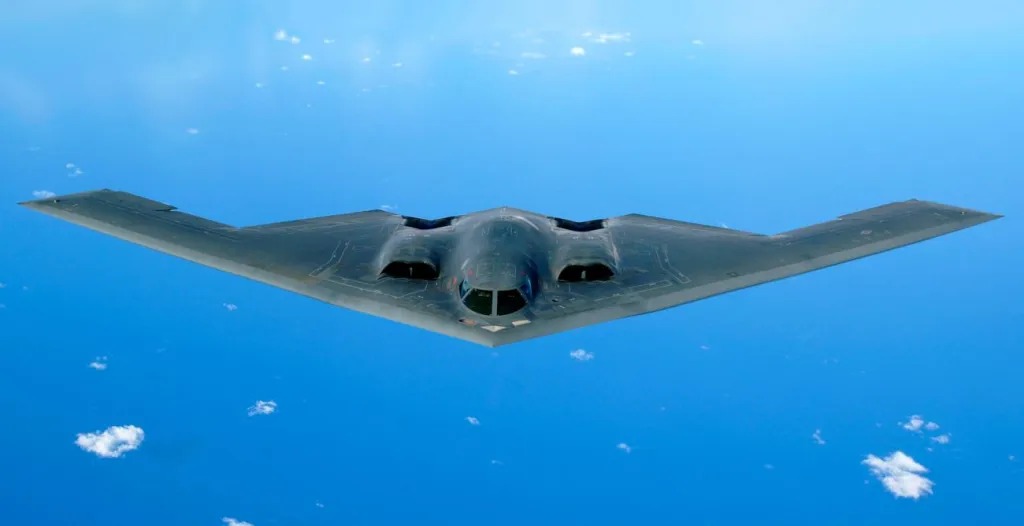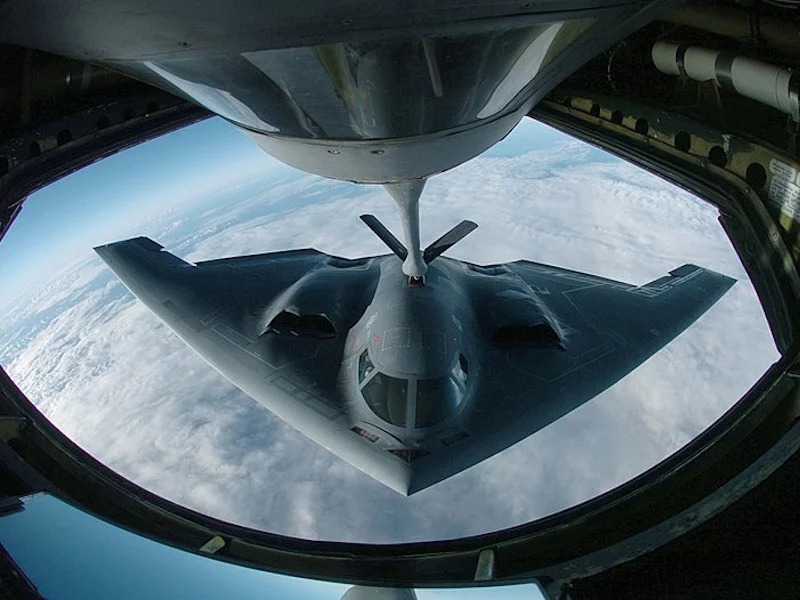The ocean is quiet. But under its deceptive calm, a storm is brewing—not of nature, but of machines engineered to unleash the fury of modern warfare. With the recent deployment of three B-2 Spirit stealth bombers to Diego Garcia, the United States hasn’t just moved aircraft—it has shifted the balance of power across an entire hemisphere.
Strategically nestled in the Indian Ocean, Diego Garcia is more than just a remote military base—it is America’s unsinkable aircraft carrier, a keystone in its Indo-Pacific strategy, and now, the closest dagger pointed toward Iran and Yemen.
The B-2s, ghosts of the sky, are capable of slipping past the most advanced air defenses and delivering devastation with surgical precision. Their presence signals one thing: the United States isn’t bluffing.
A NOTAM (Notice to Airmen) has been issued. Air corridors are being cleared. Diplomatic backchannels are heating up. But the message from Washington is loud and clear: the US is ready to act and act hard if the red lines in the Middle East are crossed.
Diego Garcia: From Staging Post To Launchpad
Diego Garcia isn’t new to strategic deployments. During the 1991 Gulf War, the US Air Force launched bombers from this isolated atoll. In the 2003 Iraq invasion, B-1 and B-52 bombers took off from there. But this time is different. This is not a long war build-up—it’s rapid positioning with a clear purpose.
B-2 bombers are America’s ace in the hole. Unlike other strategic bombers, they can fly intercontinental missions and return without refueling, all while remaining nearly invisible to radar.
Deploying them to Diego Garcia shaves hours off their sortie time to the Gulf. From this base, the B-2s can strike targets in Iran, Yemen, the Red Sea, and even beyond—within a single mission profile.

Middle East Crisis: Powder Keg Or Pressure Valve?
Tensions in the region are already combustible. The Houthis in Yemen have successfully targeted shipping vessels in the Red Sea, threatening the global Suez route.
Iran has resumed enrichment and is fuelling regional militias with arms and ideology. The Israel-Hamas war shows no signs of abating. And American bases in Iraq and Syria are increasingly coming under drone and rocket fire.
The deployment of B-2s isn’t merely deterrence—it’s preparation. In war games and real operations, stealth bombers have proven to be first-strike platforms that neutralize air defenses, command bunkers, and missile silos.
Their very presence tells Iran and its proxies: “Your options are narrowing.”
Implications For The Indian Ocean Region (IOR)
IOR Becomes the New Military Pivot
The Indian Ocean, long regarded as a shipping highway and less volatile than the Pacific or the Gulf, is now firmly in the crosshairs of global geopolitics. With the B-2s in Diego Garcia, the region transitions from being a support route to being the main stage.
1. The IOR as a Forward Operating Theatre
- The deployment of B-2 bombers to Diego Garcia transforms the Indian Ocean from a strategic backseat into a front-line operating zone.
- It’s no longer just about anti-piracy or humanitarian missions—the IOR is now part of the US rapid-response ecosystem.
- This marks a shift from peacetime naval dominance to a high-readiness military deterrence posture in the region.
2. India’s Strategic Posture Must Evolve
- As the dominant regional power, India can no longer rely on geographic insulation.
- Threats now include long-range precision strikes, hypersonic weapons, cyber warfare nodes, and electronic surveillance platforms operating from the oceanic domain.
- India must enhance its maritime domain awareness, reinforce its island-based military assets, and reconsider its western seaboard vulnerability.
3. Threat to Maritime Trade and Energy Lifelines
- Key chokepoints like Bab el-Mandeb and the Strait of Hormuz are already under duress from Houthi and Iranian maritime disruptions.
- Over 70% of India’s energy imports pass through these waters, meaning any escalation can directly impact fuel security and inflation.
- Rising shipping insurance costs and potential re-routing of global maritime traffic could spike freight rates and delay imports/exports.
4. Shift In US Strategic Basing Philosophy
- By moving stealth assets to Diego Garcia, the US minimizes risk to its Gulf-based assets and host-nation sensitivities.
- The island’s isolation allows freedom of operation without regional political blowback.
- It also sets the stage for long-range, low-footprint kinetic operations with high deniability.
🐉 5. China Will Counterbalance Assertively
- Beijing will interpret this move as an escalation and could increase submarine patrols, undersea mapping missions, and surveillance via “scientific research vessels.”
- China may double down on its presence in Djibouti and push harder on its “String of Pearls” bases across the IOR.
- This increases the risk of underwater stand-offs, intelligence warfare, and aggressive grey zone tactics.
6. Call For An Expeditionary Indian Navy
- The situation demands that India transitions from a coastal defense mindset to a blue-water power with expeditionary capability.
- Forward deployment, rapid mobilization forces, and stronger naval aviation support become essential.
- INS Baaz, INS Kadamba, and the Andaman & Nicobar Command must be fortified with dual-use civil-military logistics support.
Expect increased surveillance missions, maritime patrols, and the presence of nuclear submarines. Quad partners—India, Australia, Japan, and the US—will likely recalibrate their military doctrines to factor in rapid response scenarios emerging from Diego Garcia.
India’s Security Calculus Just Got More Complex
India’s western seaboard, its island territories (Lakshadweep, Andaman, and Nicobar), and the new naval base INS Baaz must now prepare for two kinds of scenarios:
- Collateral fallout from any US-Iran conflict spilling over into Arabian Sea shipping lanes.
- An uptick in surveillance, foreign submarine activity, and potential refugee or smuggling flows in case of a full-blown crisis.
While not directly involved, India cannot afford to remain a spectator. Our coastal radar chains, naval readiness, and port security measures must be upgraded to a war footing.

Chokepoints Under Threat
The Strait of Hormuz, Bab el-Mandeb, and the Suez Canal are vital arteries for energy shipments to India and Asia. If conflict breaks out, these chokepoints will become war zones. Insurance premiums for oil shipments will skyrocket, impacting global and Indian inflation.
The Red Sea is already experiencing disruptions due to Houthi attacks. A single B-2-led strike on Yemen could escalate the situation, drawing Iran deeper into the fray and prompting retaliatory action in the Arabian Sea.
The Broader Message: Power Projection With Stealth
What’s significant here is that the US didn’t just park F-15s or carrier strike groups—it flew in the B-2s. These are not routine deployments. Each B-2 carries nuclear and conventional precision munitions. The optics of this move are crystal clear: deterrence through capability, not words.
Diego Garcia’s remote location, far from civilian populations and vulnerable political optics, makes it the perfect black-box base for such operations. The B-2’s ability to conduct missions without support aircraft reduces its footprint, enhances surprise, and leaves adversaries guessing.
China is Watching & So Is Russia
While the focus may be on Iran and Yemen, let’s not forget who else is watching Diego Garcia. China, expanding aggressively into the Indian Ocean through Gwadar, Hambantota, and Djibouti, views any US presence as a counterweight to its own Belt and Road ambitions.
Russia, too, watches closely—seeing how the US mobilizes stealth bombers could inform its own planning in Ukraine or Syria.
India must note this. While New Delhi maintains strategic autonomy, it must also recognize that the US build-up in Diego Garcia serves a dual purpose: responding to Middle East flare-ups while silently checking Chinese adventurism in the IOR.
What Should India Do? A Three-Pronged Strategy
- Augment Strategic Awareness in the IOR
Our Poseidon P-8I fleet must increase ISR (intelligence, surveillance, reconnaissance) patrols across the Indian Ocean, from the Gulf of Aden to the Malacca Strait. - Strengthen Bilateral and Multilateral Coordination
Exercise more naval coordination with the US 5th and 7th Fleet, French, and Australian Navies, and increase the tempo of Malabar-like exercises. - Energy Security Buffering
Begin diversifying oil supply routes and explore strategic reserves since any conflict in the Gulf will choke India’s energy lifeline.
A Flashpoint Or A Firebreak?
Some argue that the B-2s will prevent war. Others fear they might trigger one. Both could be right. History has shown us that deployments of overwhelming force can either suppress an adversary’s misadventures—or provoke a desperate lunge.
Iran is cornered. The Houthis are emboldened. Israel remains in a hyper-vigilant state. And America, after Afghanistan and Ukraine, cannot afford to appear weak.
The possibility of a miscalculation is high. One missile, too many. One wrong assumption. And the skies over the Middle East could light up once again—this time with stealth bombers flying from an atoll in the Indian Ocean.
Conclusion: The Calm Before The Storm?
The deployment of B-2s to Diego Garcia marks a return to hard deterrence—a reminder that great powers still rely on the sword, not just the shield. The Indian Ocean Region is no longer a buffer—it is now a springboard.
India must tread carefully yet firmly. Our economic, maritime, and energy interests are at stake. We cannot influence the US-Iran confrontation—but we must be prepared to ride out the storm if it arrives. Strategic clarity, operational readiness, and diplomatic agility will be our best defense in the days to come.
For now, the bomb bays are closed. But the message is open.
Diego Garcia is watching. And so is the world.
- IAF Group Capt MJ Augustine Vinod VSM (R) is COO, AutoMicroUAS. The views expressed in the above piece are personal and solely those of the author. They do not necessarily reflect the EurAsian Times’ views.
- He tweets at @mjavinod




